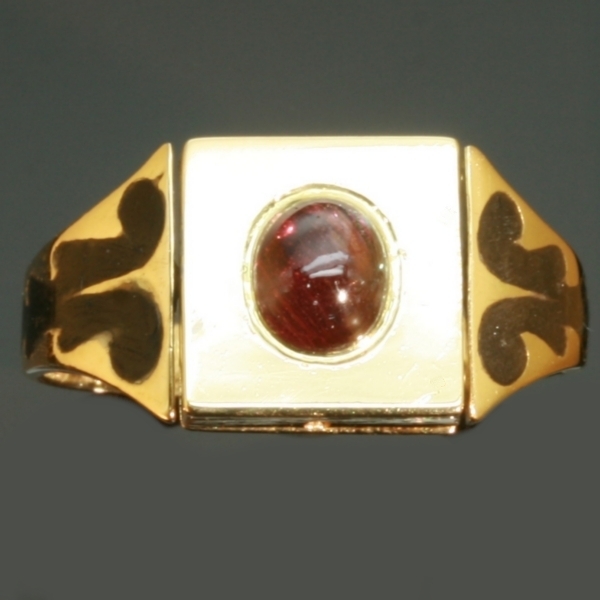We offer layaway, spread payments on the piece of your dreams. Ask us for details. Free insured shipping on all orders !!!
Two faced antique poison ring with hidden place made just after French Revolution
Almost 200 years old and still in good condition. A poison ring, but not just an "ordinary" poison ring but one with a turnable center. On one side there is a cabochon cut garnet and on the other side a little carre set with 16 rose cut diamonds. The reason why the center part can turn we can only guess about but perhaps it was used as some sort of signal inform intimo to the bearer of this ring of a certain status? Hence the red and white color? And thinking about this makes the knowledge that this ring has a secret compartment only more exciting.
Antique jewelry object group: Poison ring with turnable center part
Condition: good condition
- (more info on our condition scale)
Country of origin:
France
Style: Pre-Victorian -
- See also: Pre-Victorian
or more info on styles
Period: ca. 1817
- (events and facts in 1817)
Material: 18K yellow gold
- (more info on precious metals)
Technique:
Enamelling is an old and widely-adopted technology. The ancient Egyptians applied enamels to pottery and stone objects. The ancient Greeks, Celts, Russians, and Chinese also used enameling processes on metal objects. Enamel is the colorful result of
fusing powdered glass to a substrate by firing, usually between 750 and 850 degrees Celsius. The powder melts and flows and hardens to a smooth, durable vitreous coating on metal, glass or ceramic. According to some sources, the word enamel comes from
the High German word smelzan (to smelt) via the Old French esmail. Used as a noun, "an enamel" is a usually small decorative object, coated with enamel coating, such as a champlevé or a cloisonné (different techniques).
Extra information:
Poison ring - A type of finger ring having a hinged bezel that conceals a compartment said to have held in poison. Although no such use has been factually established, there are historical (e.g. Hannibal's death) and literary references to such rings.
It has been surmised that the compartment may usually have contained perfume or a relic.
According to info found at Wikipedia, a poison ring or pillbox ring is a type of ring with a container under the bezel or inside the bezel itself that could be used to hold poison or another substance. They became popular in Europe during the sixteenth
century.
The poison ring was used either to slip poison into an enemy's food or drink, or to facilitate the suicide of the wearer in order to escape capture or torture.
Rings like this have been used throughout history to carry perfume, locks of hair, devotional relics, messages and other keepsakes, so they have also been known by other names. Artists would paint tiny portraits of loved ones, to be carried in what was
called a “locket ring,” which was popular during the Renaissance.
By the 17th century, jewelers were creating locket rings in the shape of caskets which served as mementos for mourners. These were called “funeral rings.” Rings with compartments are also called “box” rings or “socket” rings.
The Origin of Poison Rings According to Marcy Waldie, who wrote about poison rings in the October 2001 article “A Ring to Die For: Poison Rings Hold Centuries of Secrets,” from Antiques & Collecting Magazine, this type of jewelry originated in ancient
days of the Far East and India. It replaced the practice of wearing keepsakes and other items in pouches around the neck. The wearing of vessel rings was so practical that it spread to other parts of Asia, the Middle East and the Mediterranean before
reaching Western Europe in the Middle Ages. By then the rings were part of the “holy relic trade.”(from: Wikipedia)
Diamonds:
16 rose cut diamonds. We do not have the weight of the diamonds which is normal in our trade when it comes to rose cuts.
Precious stones:
One cabochon polished
garnet
- (more info on precious stones)
Birthstones:
Diamond is the birthstone (or month stone) for April
and garnet for January.
- (more info on birthstones)
Hallmarks: The French control mark representing an ram's head that was in use in France from about 1817.
- (more info on hallmarks)
Dimensions: turnable carre 1.00 cm (0.39 inch) x 1.00 cm (0.39 inch)
Weight: 4.80 gram (3.09 dwt)
Ring size Continental: 57 & 18¼ , Size US 8 , Size UK: P½
Resizing: Free resizing, but because of the the way the ring is made, we cannot guarantee to make it on every size; so please ask in advance (only for extreme resizing we have to charge).
- (more info on ring sizes)
Reference Nº: 10252-0766
Copyright photography: Adin, fine antique jewelry
See also our:
yellow gold jewelry,
jewelry with rose cut diamonds,
jewelry with garnet,
latest acquisitions,
antique jewelry,
estate jewelry,
vintage jewelry or
modern jewelry
Jewelry with birthstones (or month stones) for:
January -
February -
March -
April -
May -
June -
July
August -
September -
October -
November or
December.
Additional information:
jewelry glossary -
wall of fame -
visit us in Antwerp -
subscribe to our mailinglist.
What is antique jewelry? -
What is estate jewelry? -
What is vintage jewelry?




